Unit 6 Lesson 32 Trains Go Faster 课件+音频(共31张PPT)冀教版八年级上册
文档属性
| 名称 | Unit 6 Lesson 32 Trains Go Faster 课件+音频(共31张PPT)冀教版八年级上册 | 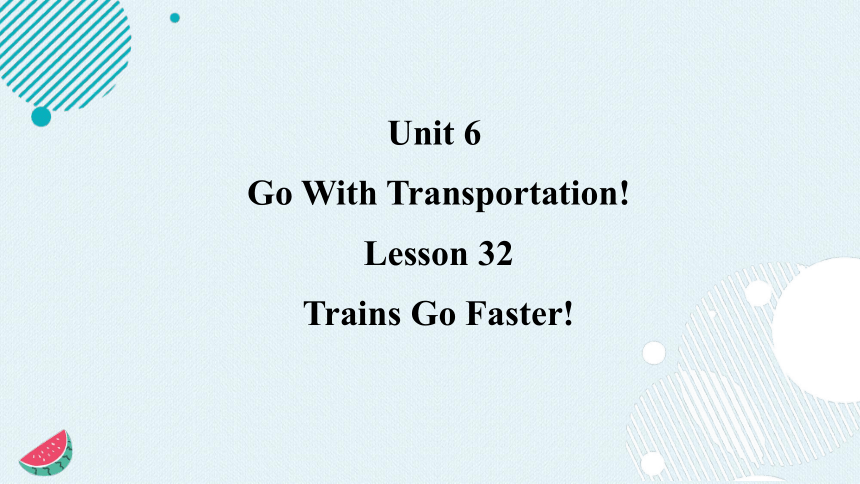 | |
| 格式 | pptx | ||
| 文件大小 | 22.5MB | ||
| 资源类型 | 教案 | ||
| 版本资源 | 冀教版 | ||
| 科目 | 英语 | ||
| 更新时间 | 2024-08-06 11:57:48 | ||
图片预览

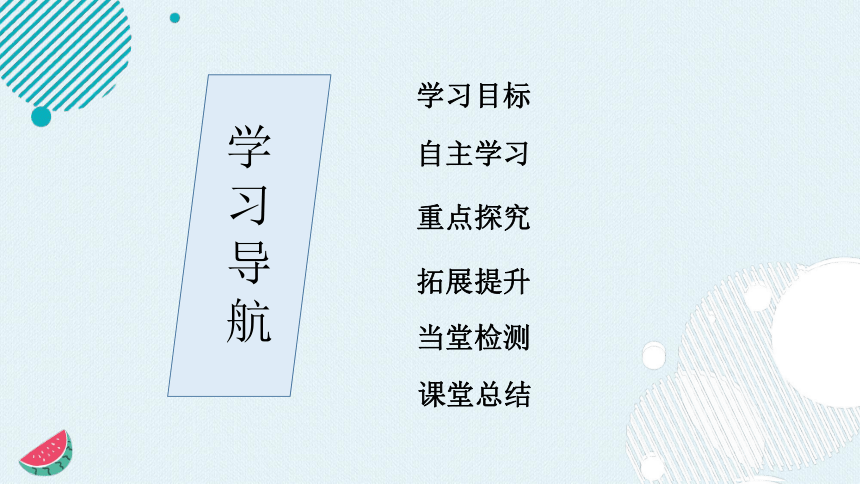
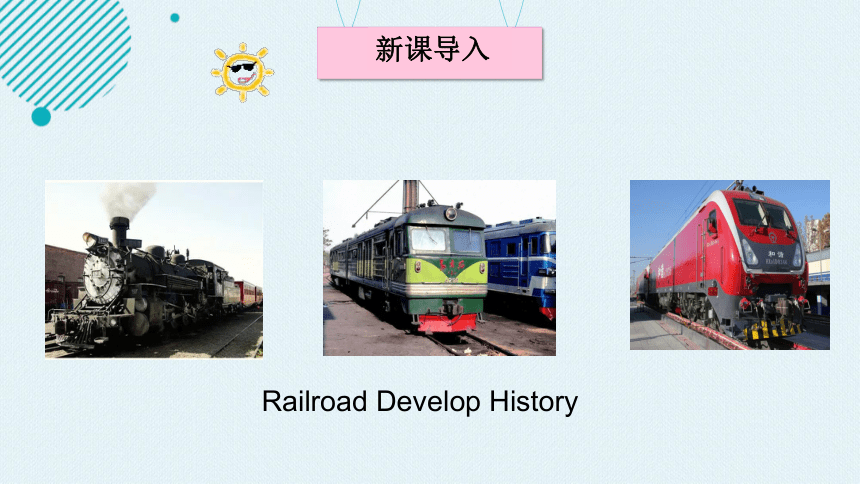
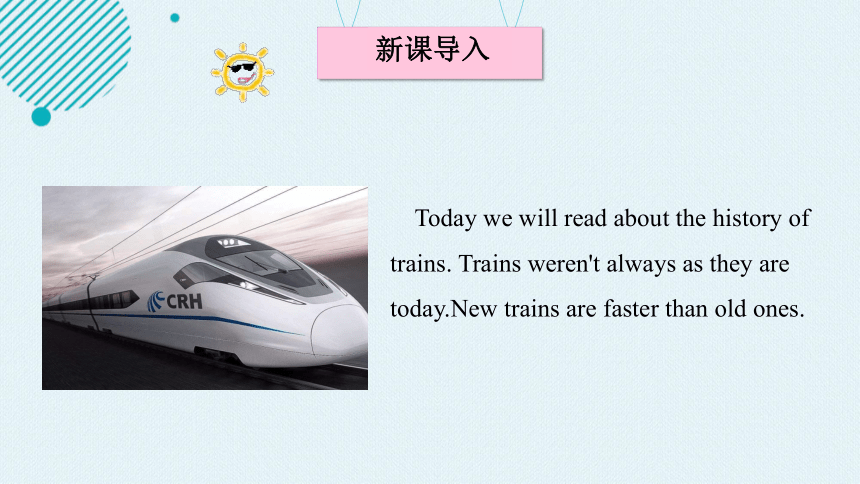

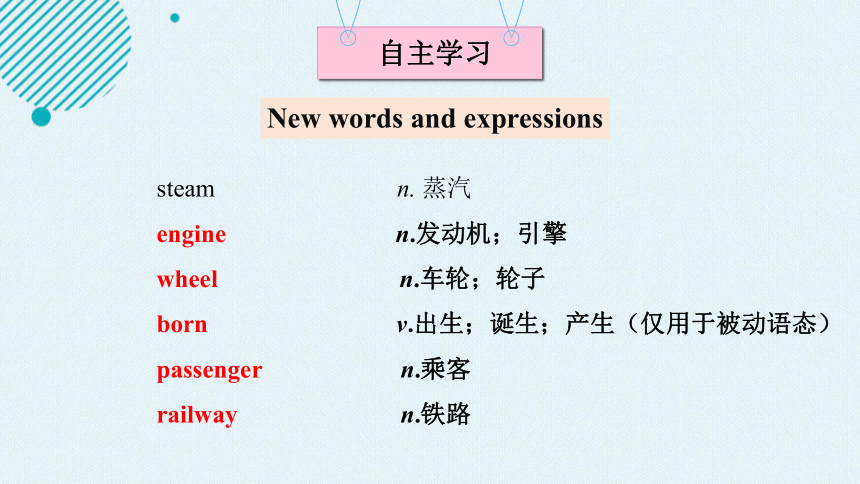
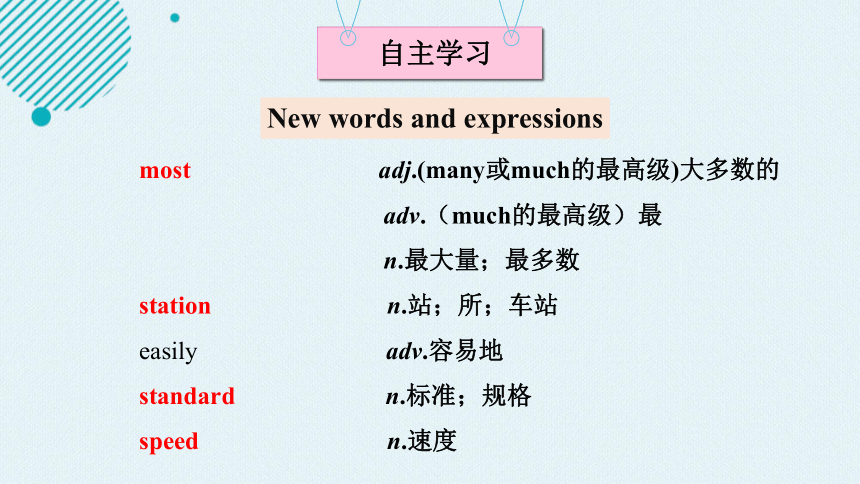


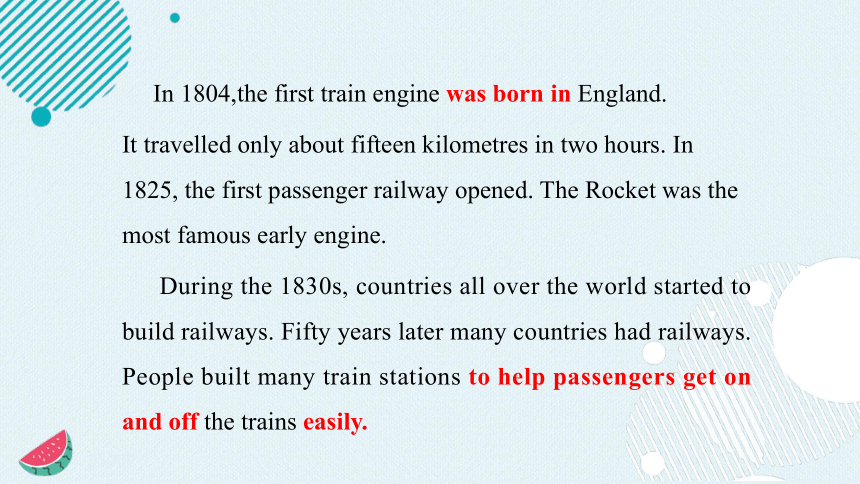
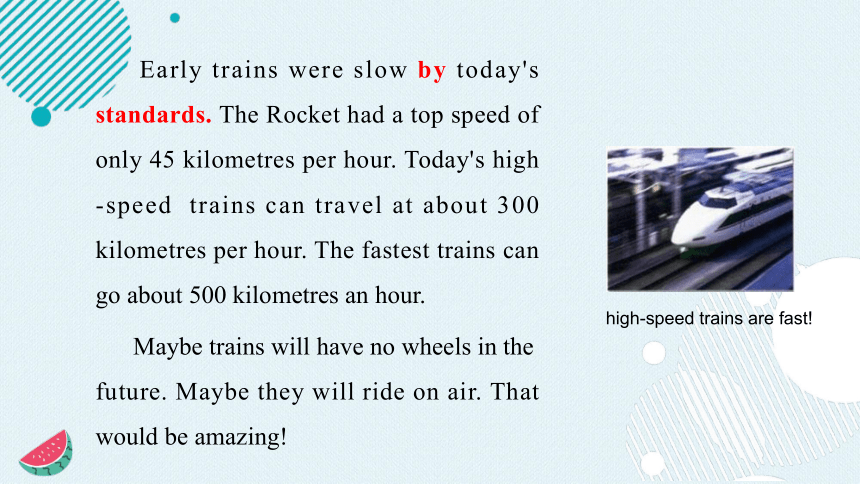
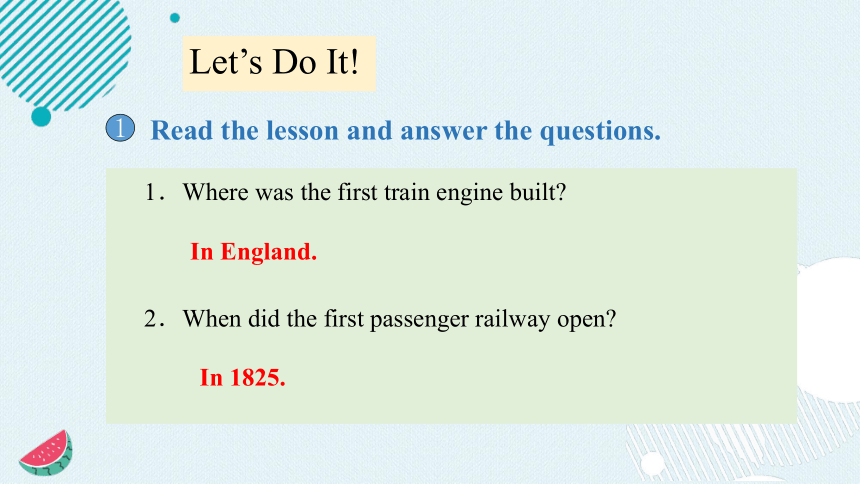
文档简介
(共31张PPT)
Unit 6
Go With Transportation!
Lesson 32
Trains Go Faster!
学习目标
重点探究
自主学习
学习导航
当堂检测
课堂总结
拓展提升
新课导入
Railroad Develop History
新课导入
Today we will read about the history of trains. Trains weren't always as they are today.New trains are faster than old ones.
学习目标
1.能熟悉并正确运用本课时的重点单词和短语
2.能掌握年份和速度的表达方式
自主学习
New words and expressions
steam n. 蒸汽
engine n.发动机;引擎
wheel n.车轮;轮子
born v.出生;诞生;产生(仅用于被动语态)
passenger n.乘客
railway n.铁路
自主学习
New words and expressions
most adj.(many或much的最高级)大多数的
adv.(much的最高级)最
n.最大量;最多数
station n.站;所;车站
easily adv.容易地
standard n.标准;规格
speed n.速度
重点探究
Think about it!
1.How do you usually travel to other cities
2.Talk about your first time taking a train.
In the 1700s, many scientists worked on steam engines. In the 1760s, a scientist in England found a way to put steam engines and wheels together. Soon people had a new type of transportation: the steam train.
In 1804,the first train engine was born in England.
It travelled only about fifteen kilometres in two hours. In 1825, the first passenger railway opened. The Rocket was the most famous early engine.
During the 1830s, countries all over the world started to build railways. Fifty years later many countries had railways. People built many train stations to help passengers get on and off the trains easily.
Early trains were slow by today's standards. The Rocket had a top speed of only 45 kilometres per hour. Today's high speed trains can travel at about 300 kilometres per hour. The fastest trains can go about 500 kilometres an hour.
Maybe trains will have no wheels in the future. Maybe they will ride on air. That would be amazing!
high-speed trains are fast!
Let’s Do It!
1
Read the lesson and answer the questions.
1.Where was the first train engine built
2.When did the first passenger railway open
In England.
In 1825.
3. How fast do today's trains go
4. What might future trains be like
Today's trains can go at about 300 kilometres per hour. The fastest trains can go about 500 kilometres an hour.
Maybe they will have no wheels and ride on air.
2
Listen to the dialogues and tick the correct information.
1.□in 1804 □in 1825 □in 1830
2.□30 kilometres an hour
□45 kilometres an hour
□54 kilometres an hour
3.□seven □seventeen □seventy
4.□50 kilometres an hour □500 metres an hour
□500 kilometres an hour
√
√
√
√
听力材料
1. A: When was the first train engine built
B: In 1804.
2. A: How fast did the Rocket travel
B: 45 kilometres per hour.
3. A: How many people did the first engine pull
B: 70 people.
4. A: How fast can the fastest trains go
B: About 500 kilometres an hour.
3
Complete the dialogue with the correct forms of the words in the box.
railway station speed passenger
Tom: Hello John. How are you doing
John: Hi Tom. I'm doing well. Have you been to our new ________ ________?
railway station
railway station speed passenger
Tom: Not yet. How about you
John: I went there last month. It's bright and beautiful. It's easy for ___________ to get on and off the train. It was exciting. The train went really fast. It can reach a top ________ of 500 kilometres an hour.
Tom: That's really fast! I hope to ride it soon.
passengers
speed
4
Read the passage and answer the questions.
Over two thousand years ago, Chinese people invented kites. Kites can fly like birds, but they can't take people up into the sky. Hundreds of years later, the Wright brothers made the first successful experiment. A machine carrying a man rose into the sky using its own energy. It was the first plane. Inventors went on to improve planes. Two engineers,Frank Whittle of the U.K. and Hans Von Ohain of Germany, developed the jet plane during the late 1930s.
1.Who invented kites
2. Can kites take people up into the sky
3. Where was Frank Whittle from?
Chinese people.
No, they can't.
The U.K.
拓展提升
language points
1.In the 1700s,many scientists worked on steam engines.
(1)“in the +年代+-s”表示“在……世纪……年代”。
in the 1760s在18世纪60年代
Most of us were born in the 1990s.
我们大多数出生于20世纪90年代。
(2)work on意为“从事,致力于;忙于”,后接名词,代词或动名词形式。
I’m sorry I can’t go out with you.I’m working on my homework.
很抱歉我不能和你出去了。我在做作业。
2.In the 1760s, a scientist in England found a way to put
steam engines and wheels together.
way表示“方式,方法”,后面经常跟不定式或of短语
作后置定语。
Another way of making new friends is to join a club.
另一种交新朋友的办法就是参加俱乐部。
He has thought of a new way to deal with that problem.
他已经想出了一个解决那个问题的新方法。
3.In 1804,the first train engine was born in England.
be born出生,产生,形成,born 是动词bear的过去分
词,be动词常用was或were。当表示出生地点或日期
时,后面可以接由介词in,at或on构成的介词短语。
He was born in Shijiazhuang.
他生于石家庄。
4.People built many train stations to help passengers get on
and off the trains easily.
(1)to help passengers 是一个不定式短语,在句中作目的状
语,表示修建火车站的目的是帮助乘客。不定式(短语)作目
的状语是不定式(短语)的一个重要功能,在英语中很常见。
I got up early to do morning exercises.
为了做早操我起得很早。
(2)get on/ off意为“上/下(车、船等)”。
I saw him get on the bus.
我看见他上了公共汽车。
After you get off the boat,please call me.
你下船后,请给我打电话。
【拓展】 get into意为“上(出租车/小汽车)”; get out of
意为“下(出租车/小汽车)”。
(3)easily为副词,意为“容易地”,是easy的副词形
式,在句中修饰实义动词。
I can finish my homework easily.
我能轻松地完成作业。
5.Early trains were slow by today’s standards.
(1)介词by在句中的意思是“按照”,后加名词或代词作宾语,在
句中常作状语,表示方式。by today’s standards 意为“根据
今天的标准”。
You have to play by the rules.
你们必修按规则比赛。
(2)standard是可数名词,意为“标准,水平”。
a new standard新标准
当堂检测
Ⅰ.根据汉语提示完成句子
1.Steve wants to be an (工程师)when he grows up.
2.They visited many places of interest (在……期间)their stay in Hangzhou.
3.The (轮子)of this car are all broken down.
4.Look! A lot of (乘客)are waiting at the station.
5.Can you tell me the (速度)of this kind of new car
engineer
during
wheels
passengers
speed
当堂检测
Ⅱ.根据汉语意思完成句子
1.根据你的标准,什么是最好的学习方法
What is the best way to study
2.李红出生于北京。
Li Hong in Beijing.
3.火车正在高速运行。
The train is running .
by your standards
was born
at a high speed
当堂检测
Ⅱ.根据汉语意思完成句子
4.科学家们正在制订一项新计划。
The scientists are a new plan.
5.一家新工厂下个月就开业了。
A new factory next month.
working on
will open
课堂总结
Unit 6
lesson 32
重点短语/句式
重点单词
born
passenger
most
standard
in the +年代+-s
work on
be born
get on/off
不定时短语做目的状语
Unit 6
Go With Transportation!
Lesson 32
Trains Go Faster!
学习目标
重点探究
自主学习
学习导航
当堂检测
课堂总结
拓展提升
新课导入
Railroad Develop History
新课导入
Today we will read about the history of trains. Trains weren't always as they are today.New trains are faster than old ones.
学习目标
1.能熟悉并正确运用本课时的重点单词和短语
2.能掌握年份和速度的表达方式
自主学习
New words and expressions
steam n. 蒸汽
engine n.发动机;引擎
wheel n.车轮;轮子
born v.出生;诞生;产生(仅用于被动语态)
passenger n.乘客
railway n.铁路
自主学习
New words and expressions
most adj.(many或much的最高级)大多数的
adv.(much的最高级)最
n.最大量;最多数
station n.站;所;车站
easily adv.容易地
standard n.标准;规格
speed n.速度
重点探究
Think about it!
1.How do you usually travel to other cities
2.Talk about your first time taking a train.
In the 1700s, many scientists worked on steam engines. In the 1760s, a scientist in England found a way to put steam engines and wheels together. Soon people had a new type of transportation: the steam train.
In 1804,the first train engine was born in England.
It travelled only about fifteen kilometres in two hours. In 1825, the first passenger railway opened. The Rocket was the most famous early engine.
During the 1830s, countries all over the world started to build railways. Fifty years later many countries had railways. People built many train stations to help passengers get on and off the trains easily.
Early trains were slow by today's standards. The Rocket had a top speed of only 45 kilometres per hour. Today's high speed trains can travel at about 300 kilometres per hour. The fastest trains can go about 500 kilometres an hour.
Maybe trains will have no wheels in the future. Maybe they will ride on air. That would be amazing!
high-speed trains are fast!
Let’s Do It!
1
Read the lesson and answer the questions.
1.Where was the first train engine built
2.When did the first passenger railway open
In England.
In 1825.
3. How fast do today's trains go
4. What might future trains be like
Today's trains can go at about 300 kilometres per hour. The fastest trains can go about 500 kilometres an hour.
Maybe they will have no wheels and ride on air.
2
Listen to the dialogues and tick the correct information.
1.□in 1804 □in 1825 □in 1830
2.□30 kilometres an hour
□45 kilometres an hour
□54 kilometres an hour
3.□seven □seventeen □seventy
4.□50 kilometres an hour □500 metres an hour
□500 kilometres an hour
√
√
√
√
听力材料
1. A: When was the first train engine built
B: In 1804.
2. A: How fast did the Rocket travel
B: 45 kilometres per hour.
3. A: How many people did the first engine pull
B: 70 people.
4. A: How fast can the fastest trains go
B: About 500 kilometres an hour.
3
Complete the dialogue with the correct forms of the words in the box.
railway station speed passenger
Tom: Hello John. How are you doing
John: Hi Tom. I'm doing well. Have you been to our new ________ ________?
railway station
railway station speed passenger
Tom: Not yet. How about you
John: I went there last month. It's bright and beautiful. It's easy for ___________ to get on and off the train. It was exciting. The train went really fast. It can reach a top ________ of 500 kilometres an hour.
Tom: That's really fast! I hope to ride it soon.
passengers
speed
4
Read the passage and answer the questions.
Over two thousand years ago, Chinese people invented kites. Kites can fly like birds, but they can't take people up into the sky. Hundreds of years later, the Wright brothers made the first successful experiment. A machine carrying a man rose into the sky using its own energy. It was the first plane. Inventors went on to improve planes. Two engineers,Frank Whittle of the U.K. and Hans Von Ohain of Germany, developed the jet plane during the late 1930s.
1.Who invented kites
2. Can kites take people up into the sky
3. Where was Frank Whittle from?
Chinese people.
No, they can't.
The U.K.
拓展提升
language points
1.In the 1700s,many scientists worked on steam engines.
(1)“in the +年代+-s”表示“在……世纪……年代”。
in the 1760s在18世纪60年代
Most of us were born in the 1990s.
我们大多数出生于20世纪90年代。
(2)work on意为“从事,致力于;忙于”,后接名词,代词或动名词形式。
I’m sorry I can’t go out with you.I’m working on my homework.
很抱歉我不能和你出去了。我在做作业。
2.In the 1760s, a scientist in England found a way to put
steam engines and wheels together.
way表示“方式,方法”,后面经常跟不定式或of短语
作后置定语。
Another way of making new friends is to join a club.
另一种交新朋友的办法就是参加俱乐部。
He has thought of a new way to deal with that problem.
他已经想出了一个解决那个问题的新方法。
3.In 1804,the first train engine was born in England.
be born出生,产生,形成,born 是动词bear的过去分
词,be动词常用was或were。当表示出生地点或日期
时,后面可以接由介词in,at或on构成的介词短语。
He was born in Shijiazhuang.
他生于石家庄。
4.People built many train stations to help passengers get on
and off the trains easily.
(1)to help passengers 是一个不定式短语,在句中作目的状
语,表示修建火车站的目的是帮助乘客。不定式(短语)作目
的状语是不定式(短语)的一个重要功能,在英语中很常见。
I got up early to do morning exercises.
为了做早操我起得很早。
(2)get on/ off意为“上/下(车、船等)”。
I saw him get on the bus.
我看见他上了公共汽车。
After you get off the boat,please call me.
你下船后,请给我打电话。
【拓展】 get into意为“上(出租车/小汽车)”; get out of
意为“下(出租车/小汽车)”。
(3)easily为副词,意为“容易地”,是easy的副词形
式,在句中修饰实义动词。
I can finish my homework easily.
我能轻松地完成作业。
5.Early trains were slow by today’s standards.
(1)介词by在句中的意思是“按照”,后加名词或代词作宾语,在
句中常作状语,表示方式。by today’s standards 意为“根据
今天的标准”。
You have to play by the rules.
你们必修按规则比赛。
(2)standard是可数名词,意为“标准,水平”。
a new standard新标准
当堂检测
Ⅰ.根据汉语提示完成句子
1.Steve wants to be an (工程师)when he grows up.
2.They visited many places of interest (在……期间)their stay in Hangzhou.
3.The (轮子)of this car are all broken down.
4.Look! A lot of (乘客)are waiting at the station.
5.Can you tell me the (速度)of this kind of new car
engineer
during
wheels
passengers
speed
当堂检测
Ⅱ.根据汉语意思完成句子
1.根据你的标准,什么是最好的学习方法
What is the best way to study
2.李红出生于北京。
Li Hong in Beijing.
3.火车正在高速运行。
The train is running .
by your standards
was born
at a high speed
当堂检测
Ⅱ.根据汉语意思完成句子
4.科学家们正在制订一项新计划。
The scientists are a new plan.
5.一家新工厂下个月就开业了。
A new factory next month.
working on
will open
课堂总结
Unit 6
lesson 32
重点短语/句式
重点单词
born
passenger
most
standard
in the +年代+-s
work on
be born
get on/off
不定时短语做目的状语
同课章节目录
- Unit 1 Me and My Class
- Lesson 1 Back to School!
- Lesson 2 Many Faces, One Picture
- Lesson 3 Getting to Know You!
- Lesson 4 Best Friends
- Lesson 5 Meet Ms. Liu
- Lesson 6 Jenny's Week
- Unit 2 My Favourite School Subject
- Lesson 7 Don't Be Late for Class!
- Lesson 8 E-mail Helpers!
- Lesson 9 I Don't Want to Miss Geography !
- Lesson 10 Looking for Lisa
- Lesson 11 Lily Learns about China !
- Lesson 12 Karen's Hair Stood Up!
- Unit Review
- Unit 3 Families Celebrate Togethe
- Lesson 13 I Love Autumn
- Lesson 14 Happy Memories
- Lesson 15 A Present for Li Ming!
- Lesson 16 Happy Thanksgiving!
- Lesson 17 Presents from Canada!
- Lesson 18 Li Ming's Birthday
- Unit Review
- Unit 4 My Neighbourhood
- Lesson 19 The Best Neighourhood
- Lesson 20 No Stopping!
- Lesson 21 Eat a Donut and Turn Right
- Lesson 22 I Like My Neighbourhood
- Lesson 23 People in My Neighbourhood
- Lesson 24 I Need a Map!
- Unit Review
- Unit 5 My Future
- Lesson 25 I Want to Be a Teacher!
- Lesson 26 What Will I Be ?
- Lesson 27 What's Your Advice?
- Lesson 28 Rich or Poor? It Doesn't Matter!
- Lesson 29 Our Ambitions and Dreams
- Lesson 30 A Famous Friend?
- Unit Review
- Unit 6 Go With Transportation !
- Lesson 31 How Do You Travel ?
- Lesson 32 Trains Go Faster !
- Lesson 33 Life on Wheels
- Lesson 34 Flying Donuts
- Lesson 35 Future Transportation
- Lesson 36 Clean Cars ?
- Unit Review
- Unit 7 Enjoy Your Hobby
- Lesson 37 What's Your Hobby ?
- Lesson 38 Hobbies Are Fun!
- Lesson 39 Danny's Hobby
- Lesson 40 What's Paul's Hobby?
- Lesson 41 Show and Tell!
- Lesson 42 The New Club
- Unit Review
- Unit 8 Celebrating Me
- Lesson 43 What Makes You Unique?
- Lesson 44 Georgia Plays Basketball
- Lesson 45 Be Yourself !
- Lesson 46 My Dream
- Lesson 47 I Made It !
- Lesson 48 Li Ming's Report
- Unit Review
